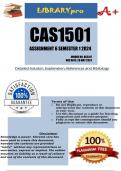CAS1501
ASSIGNMENT 6 SEMESTER 1 2024
UNIQUE NO. 865417
DUE DATE: 28 MAY 2024
,B.1.1.1 Using the CASE STUDY, COPY the FULL NAME of the bank as mentioned in
the text (not the headline) of the article.
ANSWER:
The full name of the bank mentioned in the text of the article is VBS
Mutual Bank. That is Venda Building Society.
B.1.1.2 From the CASE STUDY, in one full sentence summarise fully what happened to
the bank in 2018.
Answer:
In 2018, VBS Mutual Bank was declared insolvent and bankrupt, leading to
the defrauding of South African citizens and taxpayers out of
approximately R2 billion. This resulted in the bank being placed under
curatorship. A Reserve Bank report revealed that the bank operated in a
fraudulent and reckless manner, enriching its senior managers, politicians,
and some board members at the expense of its depositors. The bank’s
downfall was marked by the mismanagement and fraudulent activities
uncovered during a forensic investigation initiated by the Reserve Bank.
B.1.1.3 From the CASE STUDY, in one sentence summarise what was the wider
consequence to others mentioned in the article have been following what had
happened to the bank in 2018.
Answer:
The wider consequence to others mentioned in the article who have been
following what happened to the bank in 2018 was a loss of trust in the
auditing profession and heightened scrutiny of financial institutions'
compliance and ethical standards, leading to increased regulatory
oversight and calls for transparency and accountability within the banking
sector.
In conclusion, the VBS Mutual Bank scandal had far-reaching
consequences, impacting public trust in financial institutions,
regulatory oversight frameworks, auditing practices, and
socioeconomic well-being. It served as a wake-up call for
stakeholders across the financial sector to prioritize integrity,
transparency, and accountability in their operations.
B.1.2.1 Using the CASE STUDY, give the name and surname of the individual that the
article reports on
Answer:
, Stuvia.com - The study-notes marketplace
The individual reported on in the case study is Dumisani Tshuma
B1.2.2 Using the case study, give the name and surname of the co- accused of the
individual in B1.2.1
Answer:
The co-accused of Dumisani Tshuma mentioned in the case study is
Sipho Malaba
1. Dumisani Tshuma: He is a former partner at KPMG who resigned
in 2018 amidst allegations of misconduct related to loans from VBS
Mutual Bank. Tshuma admitted guilt for failing to disclose his
interest in VBS and faced disciplinary action by the Independent
Regulatory Board for Auditors (Irba). Tshuma was fined R200,000 by
Irba for his misconduct.
2. Sipho Malaba: Malaba, another former partner at KPMG, was the
co-accused of Dumisani Tshuma in the VBS scandal. Like Tshuma,
Malaba was involved in the failure to disclose loans held with VBS
and faced disciplinary proceedings by Irba. He was part of the audit
team for VBS at KPMG and was also the engagement partner.
Malaba's failure to disclose his loans with VBS contributed to the
wider scandal surrounding the bank's collapse.
Both individuals were implicated in misconduct related to their roles
at KPMG and their involvement with VBS Mutual Bank, which
ultimately led to regulatory action and fines imposed by Irba.
B.1.2.3 Using the case study, in one or two full sentences, describe the PROFESSIONAL
connection between the individual in B1.2.1
Answer:
The professional connection between Dumisani Tshuma and Sipho Malaba
lies in their shared roles as former partners at KPMG and their
involvement in the VBS scandal, where they were both implicated for
failing to disclose their interests in VBS Mutual Bank and faced disciplinary
proceedings by the Independent Regulatory Board for Auditors (Irba).
In summary, the professional connection between Dumisani Tshuma
and Sipho Malaba at KPMG, coupled with their involvement in the
VBS scandal and subsequent regulatory action, highlights the
importance of ethical conduct, transparency, and accountability in
the auditing profession. Their case serves as a cautionary tale for
auditors and professionals in the financial sector, emphasizing the
need for stringent adherence to ethical standards and regulatory
requirements to maintain public trust and confidence.




